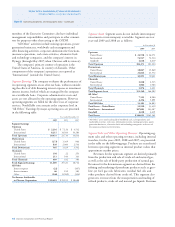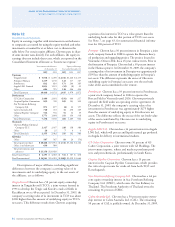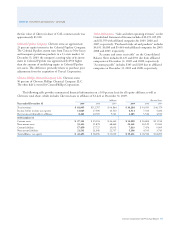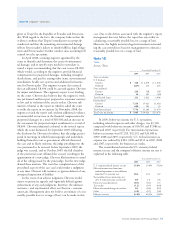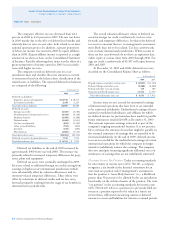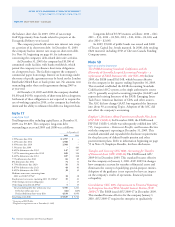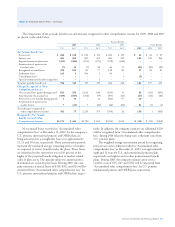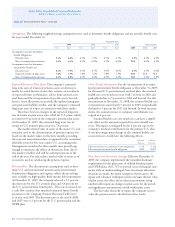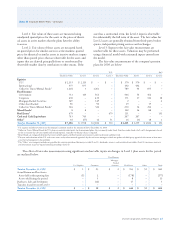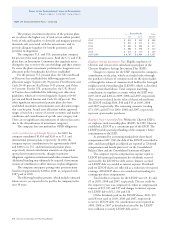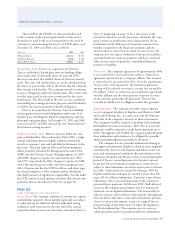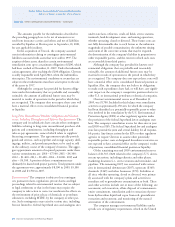Chevron 2009 Annual Report Download - page 58
Download and view the complete annual report
Please find page 58 of the 2009 Chevron annual report below. You can navigate through the pages in the report by either clicking on the pages listed below, or by using the keyword search tool below to find specific information within the annual report.
56 Chevron Corporation 2009 Annual Report
FS-PB
the balance sheet date. In 2009, $350 of tax-exempt
Gulf Opportunity Zone bonds related to projects at the
Pascagoula Refinery were issued.
The company periodically enters into interest rate swaps
on a portion of its short-term debt. At December 31, 2009,
the company had no interest rate swaps on short-term debt.
See Note 10, beginning on page 46, for information
concerning the company’s debt-related derivative activities.
At December 31, 2009, the company had $5,100 of
committed credit facilities with banks worldwide, which
permit the company to refinance short-term obligations
on a long-term basis. The facilities support the company’s
commercial paper borrowings. Interest on borrowings under
the terms of specific agreements may be based on the London
Interbank Offered Rate or bank prime rate. No amounts were
outstanding under these credit agreements during 2009 or
at year-end.
At December 31, 2009 and 2008, the company classified
$4,190 and $4,950, respectively, of short-term debt as long-term.
Settlement of these obligations is not expected to require the
use of working capital in 2010, as the company has both the
intent and the ability to refinance this debt on a long-term basis.
Note 17
Long-Term Debt
Total long-term debt, excluding capital leases, at December 31,
2009, was $9,829. The company’s long-term debt
outstanding at year-end 2009 and 2008 was as follows:
At December 31
2009 2008
3.95% notes due 2014 $ 1,997 $–
3.45% notes due 2012 1,500 –
4.95% notes due 2019 1,500 –
5.5% notes due 2009 – 400
8.625% debentures due 2032 147 147
7.327% amortizing notes due 20141 109 194
8.625% debentures due 2031 107 108
7.5% debentures due 2043 83 85
8% debentures due 2032 74 74
9.75% debentures due 2020 56 56
8.875% debentures due 2021 40 40
8.625% debentures due 2010 30 30
Medium-term notes, maturing from
2021 to 2038 (5.97%)2 38 38
Fixed interest rate notes, maturing 2011 (9.378%)2 19 21
Other foreign currency obligations – 13
Other long-term debt (6.69%)2 5 15
Total including debt due within one year 5,705 1,221
Debt due within one year (66) (429)
Reclassified from short-term debt 4,190 4,950
Total long-term debt $ 9,829 $ 5,742
1 Guarantee of ESOP debt.
2 Weighted-average interest rate at December 31, 2009.
Note 16 Short-Term Debt – Continued
Long-term debt of $5,705 matures as follows: 2010 – $66;
2011 – $33; 2012 – $1,520; 2013 – $21; 2014 – $2,020; and
after 2014 – $2,045.
In 2009, $5,000 of public bonds was issued, and $400
of Texaco Capital Inc. bonds matured. In 2008, debt totaling
$822 matured, including $749 of Chevron Canada Funding
Company notes.
Note 18
New Accounting Standards
The FASB Accounting Standards Codification and the
Hierarchy of Generally Accepted Accounting Principles – a
replacement of FASB Statement No. 162 (FAS 168) In June
2009, the FASB issued FAS 168, which became effective
for the company in the quarter ending September 30, 2009.
This standard established the FASB Accounting Standards
Codification (ASC) system as the single authoritative source
of U.S. generally accepted accounting principles (GAAP) and
superseded existing literature of the FASB, Emerging Issues
Task Force, American Institute of CPAs and other sources.
The ASC did not change GAAP, but organized the literature
into about 90 accounting Topics. Adoption of the ASC did
not affect the company’s accounting.
Employer’s Disclosures About Postretirement Benefit Plan Assets
(FSP FAS 132(R)-1) In December 2008, the FASB issued
FSP FAS 132(R)-1, which was subsequently codified into ASC
715, Compensation – Retirement Benefits, and became effective
with the company’s reporting at December 31, 2009. This
standard amended and expanded the disclosure requirements
for the plan assets of defined benefit pension and other
postretirement plans. Refer to information beginning on page
59 in Note 21, Employee Benefits, for these disclosures.
Transfers and Servicing (ASC 860), Accounting for Transfers
of Financial Assets (ASU 2009-16) The FASB issued ASU
2009-16 in December 2009. This standard became effective
for the company on January 1, 2010. ASU 2009-16 changes
how companies account for transfers of financial assets and
eliminates the concept of qualifying special-purpose entities.
Adoption of the guidance is not expected to have an impact
on the company’s results of operations, financial position
or liquidity.
Consolidation (ASC 810), Improvements to Financial Reporting
by Enterprises Involved With Variable Interest Entities (ASU
2009-17) The FASB issued ASU 2009-17 in December 2009.
This standard became effective for the company January 1,
2010. ASU 2009-17 requires the enterprise to qualitatively
Notes to the Consolidated Financial Statements
Millions of dollars, except per-share amounts




